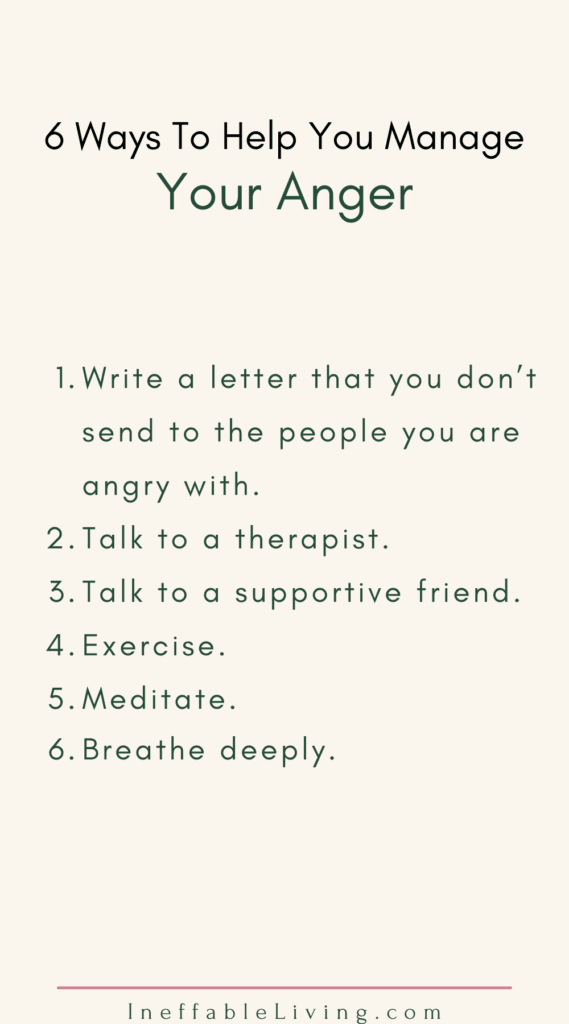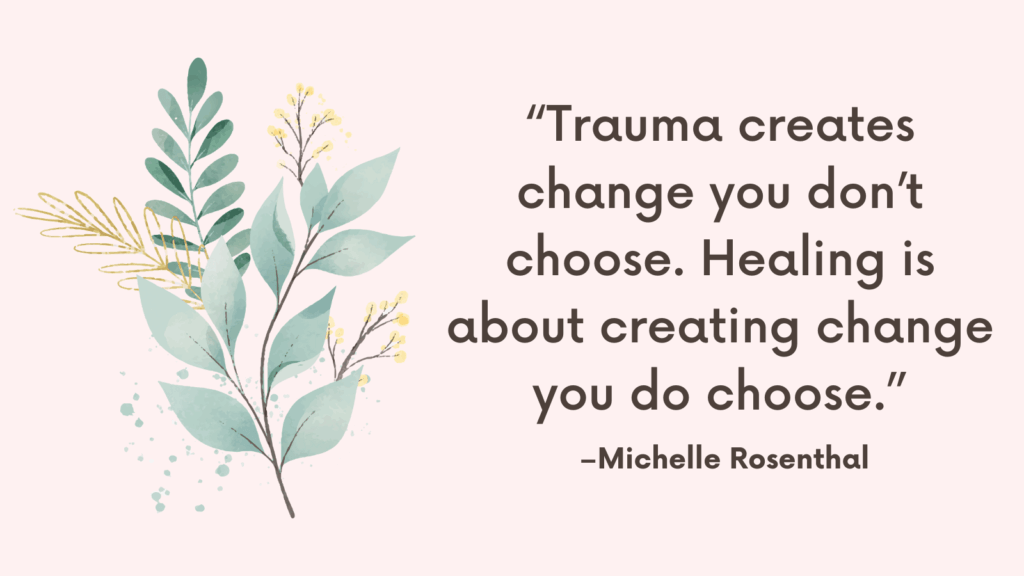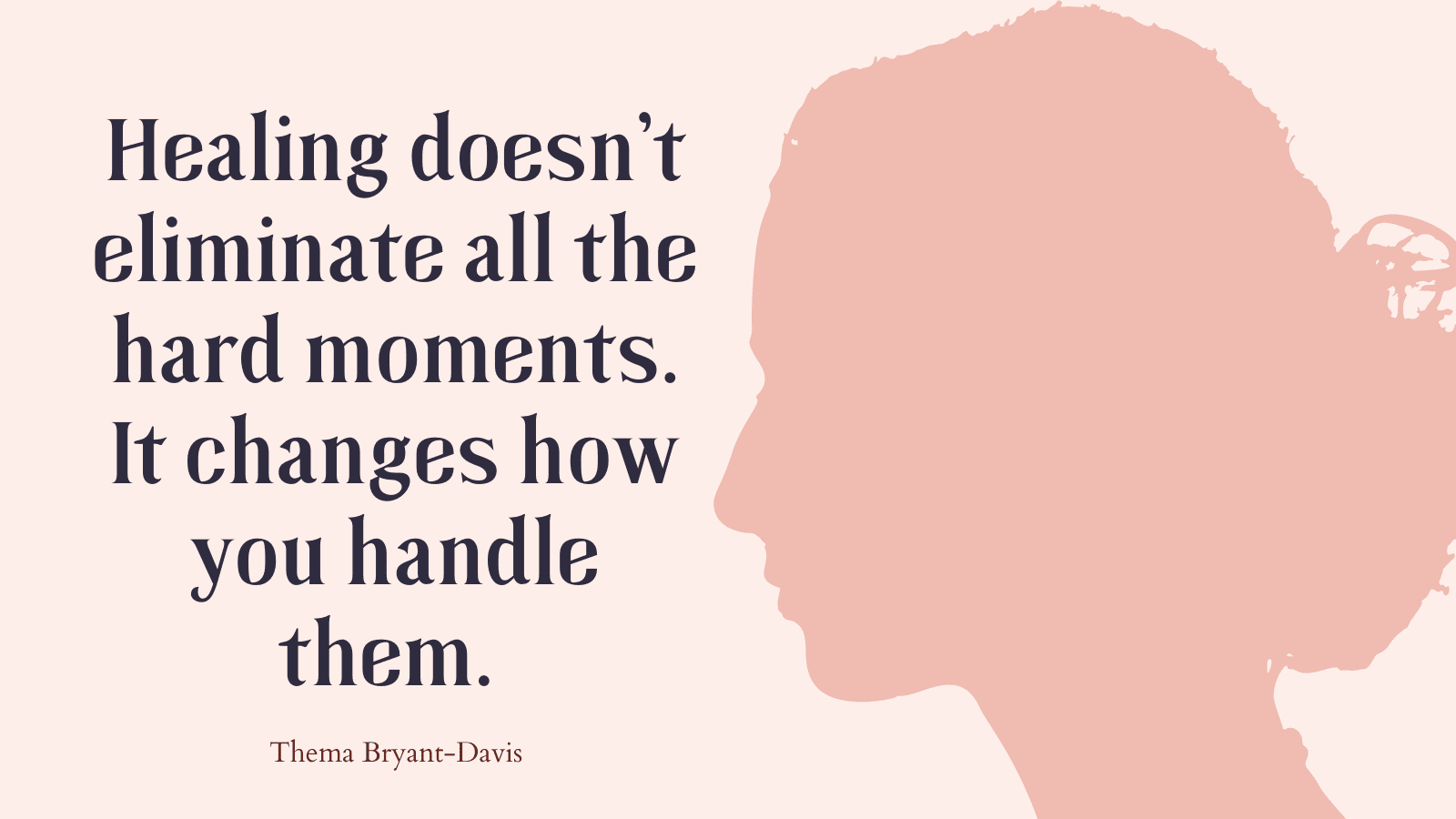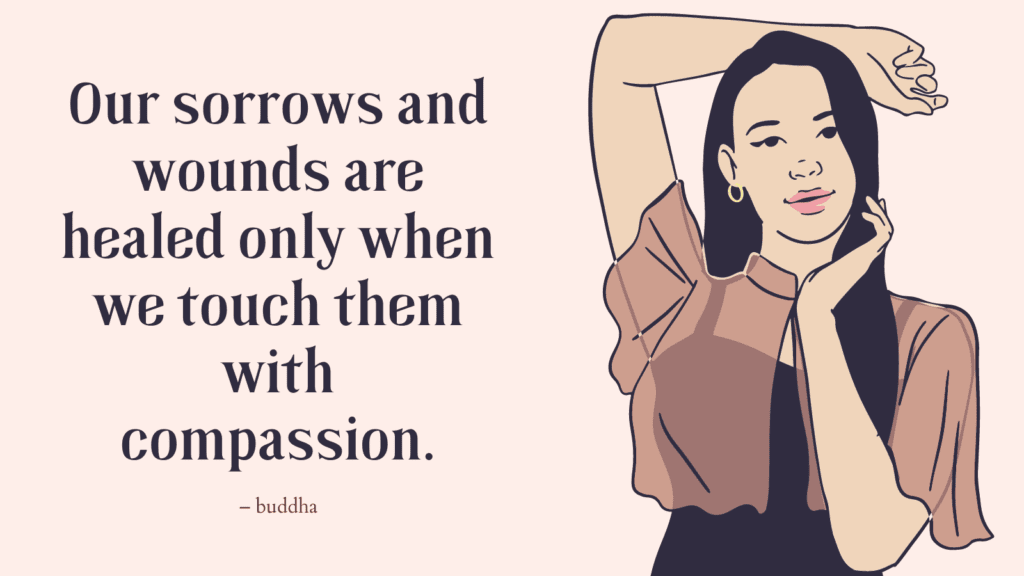This post contains signs you are healing from trauma and strategies to help you build emotional resilience while you’re healing from trauma.
What Is Post-Traumatic Stress Disorder PTSD?
Post-traumatic stress disorder, or PTSD, happens when the trauma victim gets stuck in a cycle of a negative state of fear, shame, anger, and hiding.
If you have untreated PTSD, you may feel like the world isn’t the safe place you used to think it is. Your life becomes overcast with anxiety, anger or resentment over everything.
A lot of your energy is expended to avoid the horrors in your head.
Fortunately, modern psychology treatments are highly effective to help trauma victim, but they need to first come out of hiding and seek help. (*)
Related: Why Is Trauma Therapy So Hard? (+Best Trauma Healing Exercises To Support Your Recovery)
13 Signs You Are Healing From Trauma
How many of these steps in your healing journey have you worked through?
How many of these steps in your healing journey have you worked through?
1. You believe that something terrible happened to you and that you’re not just imagining it.
2. You are aware at some level that you are a trauma survivor.
3. You are ready to deal with your feelings of being damaged or unworthy of love.
4. You feel rage toward the perpetrator of the trauma.
5. You have discussed your traumatic experiences with safe people.
6. I have begun to release undeserved guilt or feelings of any personal responsibility for what happened.
7. You recognize that you acted appropriately, given what you know at the time of the trauma.
8. You are beginning to understand how the trauma has impacted you and your current relationships.
9. You are beginning to gain more control around aspects of yourself and your life that are impacted by the trauma.
10. You have a positive sense of self.
11. You have successful intimate relationships.
12. You are in touch with your anger but you are no longer controlled by it.
13. You came to realize that by forgiving, you are reclaiming your own personal power.
Related: 7 Trauma Release Exercises To Support Your Recovery After Trauma
Understanding PTSD Symptoms and Triggers
1. PTSD Symptoms
There are at least four classes of PTSD symptoms that help the victim avoid or escape the pain caused by trauma:
1. Reliving the event
This is called a flashback. The memories of the traumatic event can return at any time and the victim can feel the same fear as when the event took place.
The flashback can be triggered by a sound or a sight such as hearing a loud noise, seeing a car accident, or even seeing the news.
2. Avoiding situations that remind the victim of the event
To avoid the pain, victims try to avoid situations or people that trigger memories of the traumatic event. They might even avoid thinking or talking about it.
That includes avoiding watching TV news or certain movies or places associated with the traumatic event, or even getting help so as not to talk about or think about the event.
They might also distract themselves with work or being busy.
3. Feeling numb
Victims might forget parts of traumatic event or stay away from interactions and activities to avoid any triggers.
4. Feeling keyed up
Because of their sensitivity to danger, people with PTSD are constantly on-guard and alert for danger.
This makes them prone to get easily startled. They might find it difficult to concentrate and have trouble sleeping.
5. Other possible symptoms
- Health problems with no easily identified causes;
- Feelings of shame and hopelessness;
- Difficulty to control emotions and behavior;
- Communication and relationship problems with family, friends, co-workers or even strangers;
- Impulsive or destructive behavior, such as substance abuse;
- A change in beliefs and/or personality traits.
The distress and impairment caused by PTSD can affect every area of a person’s life – marriage, family life, social life, student or professional life.
These symptoms show up at a variety of rates and usually occur within a month following the trauma.
For some these symptoms may not appear until several months or years. This is especially true for those who think they are strong and self-sufficient or who see these symptoms as a sign of weakness, such as the military.
In any case, ignoring the symptoms for too long can cause a setback to one’s life especially when they’re ignored through self-destructive behavior such as substance abuse or relationships avoidance.
Related: Best 9 Tips On How To Stop Avoidance Coping (+FREE Worksheets PDF)
2. How to Cope with Triggers?
Since it’s hard to avoid triggers and avoidance makes things worse in the long term, it’s important to learn coping strategies that help you limit the impact of a trigger on your PTSD symptoms.
The following strategies can help you manage your triggers.
1. Mindfulness
Mindfulness of your external environment is one of the best strategies to cope with triggers. It involves approaching the present moment nonjudgmentally, without evaluating the experience in any way.
In other words, you expand your awareness to everything happening around you and prevent your thoughts from focusing just on the trigger or symptoms.
Exercise: Mindfulness of Your External Environment
* Stop for a moment and scan your environment.
* Notice your surroundings and describe what you see, hear, smell, and feel on the surface of your body, such as a tree, the chirping of bird, the sun on your face, your clothes against your body, etc.
* Do your best to describe in details every object in your awareness.
* If you notice that your attention becomes focused on your PTSD trigger or symptoms, that’s okay. Acknowledge that your attention went back to the trigger or symptom and then gently bring your attention back to your external environment.
You can use this technique whenever a trigger catches your attention. “Stop, Take a breath, Observe what’s going on around you, and Proceed”
2. Grounding
Mindfulness is a form of grounding that keeps you in the present moment. But there are more specialized grounding exercises that connect you with the present moment quickly and completely, especially when a trigger brings about flashbacks or dissociation.
The following are some examples of grounding exercises, but you can come up with your own, the more options you have available, the better:
Exercise: Grounding
- Smell something with a strong odor
- Grab ahold of the armrest of your chair
- Bite into a lemon
- Take a cold shower or splash cold water on your face
- Hold onto an ice cube
- touch something rough
- Breathe deeply
- Visualize the face or the voice of someone you love
3. Distraction
Distraction aims to pull your attention away from a trigger. This is especially helpful for internal triggers such as intense thoughts, emotions, or bodily sensations.
The distraction activity or activities you’re going to choose need to be interesting or stimulating for you.
Keep in mind that distraction is designed to be temporary and a healthy activity. You don’t want to use distraction as a form of avoidance because this will only make the trigger stronger.
The following are some examples of distraction exercises, but you can come up with your own, the more options you have available, the better:
Exercise: Using Distraction to Manage Triggers
- Do puzzles or crosswords
- Play a game on your phone
- Do some form of physical exercise
- Talk to a friend about something unrelated to your trigger
- Read an engaging book or magazine article
- Do crafts
- Look at picture of places you have been or would like to visit
- Play with your pet
- Drink a cup of soothing tea
Can you develop post-traumatic stress disorder (PTSD) from work?
Most people believe that PTSD and trauma happen only from childhood abuse, military and wartime experiences, terrorist attacks, or natural disasters.
But we can also develop PTSD from toxic work environments and jobs that expose us to traumatizing experiences.
Workers such as doctors, nurses, EMTs, police officers, firefighters, and other workers are routinely exposed to extremely stressful events.
Healing Trauma Worksheets

Best 5 Strategies To Build Emotional Resilience
True recovery requires accepting and processing the trauma you have experienced and living with. It requires acknowledging that you’re in any danger even if your body is still reacting to danger.
In the case of jobs that are highly stressful, the stress is ongoing. However, you can continually work toward processing traumatic experiences so you can prevent any posttraumatic stress.
#1. Reach Out For Support
When you reach out to a safe person and feel not just understood but also felt, your body releases a surge of oxytocin (bonding and closeness hormone) that often induces crying from relief and feeling safe.
When oxytocin goes up, cortisol (the stress hormone) goes down, and that previously stressed-out person calms down and engages in a rational and constructive conversation.
Therapy can be the best way to find that support, but having a safe person with whom you can open up about your traumatic experience can also help.
If you can’t think of a safe person who’s willing to listen, try 7cups of tea. It is an online service with thousands of volunteer listeners stepping up to lend a friendly ear.
#2. Manage Stress
Learning how to manage your stress is especially useful when you feel triggered by anything that reminds you of the trauma, such as sirens, news stories, etc.
Exercise 1: Stress Relief Exercise
Notice your feelings and your reactions to your feelings by taking a pause and mentally answering the following questions:
- What just happened?
- What did I think when it happened?
- What did I feel when it happened?
- What does it make me want to do now?
Take a deep, calming breath.
- What would be a healthier thing to do now?
- Why is that healthier?
Recall what just happened that made you feel triggered and think about the feelings and thoughts you had. Then think about what that made you want to do – sometimes people cope with painful emotions through addictions and destructive behaviors.
Before you act on your impulses, pause, take a few calming breaths, and think about what a healthier option to manage your painful emotions would be.
6. Healthier Ways to Manage Stress
- Take a ten-minute walk.
- Lift weight
- Contact a close friend or a safe family member
- Meditate for 10 minutes
- Listen to soothing music
- Practice deep breathing for 5 minutes.
Apps like Prana Breath, MindShift CBT, Breath Ball, and Health through Breath can help make breathing exercises easier.
Exercise 2: Breathing Exercise
Deep breathing, especially abdominal breathing helps calm your nervous system and stimulate the vagus nerve – the nerve that connects your brain to your digestive system, heart, lungs, throat, and facial muscles and helps regulate autonomic nervous system ANS.
To try the exercise, follow these steps:
1. Start by noticing your breath.
2. Breathe deeply through your nose and into your belly (not into your chest).
3. Make a “voo” sound on your exhale to help stimulate the vagus nerve.
4. Repeat the exercise three to five times and notice if you feel calmer.
Exercise 3: Journaling
Journaling is a great way to process your emotions and thoughts.
Use the same questions in the first and answer them.
You can even think about a supportive friend, a mentor, or any safe person, living or deceased, and imagine them asking these questions and supporting you.
Imagine this person’s support can cause a surge of oxytocin as if you were talking to them for real.
Related: Best 21 Evening Journal Prompts To Help You Relax & Unwind

#3. Manage Your Anger
When you have PTSD or have faced trauma, anger can reach unhealthy levels and it can harm you and your loved ones.
Here are a few guidelines to help you control your anger:
1. Notice What Happens When Anger Hits
Awareness is the first step to get control of your emotions, not just anger.
1. Notice where you feel the tension in your body. Is there a knot in your stomach? Are you clenching your jaw?
2. Notice what thoughts you have about what this anger makes you want to do. Do you feel like screaming at the next person you see? Breaking something?
3. Imagine what would happen if you actually act on your impulses and mentally review all possible consequences.
4. Ask yourself, “What is a healthier thing to do instead?” and, “What the benefits of that alternative would be?”
Related: How To Manage Your Anger In Healthy, Effective Ways?
2. Take a Pause
When you start feeling angry, take time-off, if possible.
Go for a walk, or distract yourself with another activity.
If you’re with someone else, ask for time-off or excuse yourself to the restroom and take a minute to cool your temper.
3. Use “I” Messages
When you have an argument with someone, keep the focus on how you feel, rather than on another person’s faults.
Instead of saying,
“You did this,”
“You made me feel awful.”
try saying,
“I feel this way …”
“I felt hurt when …”
“I got frustrated by …”
Using I statements, gives the other person insight into your true feelings, without making them feel blamed.
4. Get Some Exercise
Exercise is a healthy way to release feelings of anger.
When you feel your anger surging, do aerobic exercise or go for a run. Housecleaning or yard work can also help release anger.
Related: Definitive Guide to Relieve Stress Instantly and Lead a Peaceful Life

#4. Manage The Demands of Work
You will likely need to continue working while dealing with the trauma, and your work environment being the major cause of trauma in the first place can make healing even more challenging.
This is why it is important to incorporate small ways to help you get through each day, including the rough ones.
1. Instant Relaxation Techniques
Using your imagination to picture relaxing memories or places can help ease your intense emotions.
1. Get in a comfortable position.
2. Start breathing deeply and slowly and feel your body as you release any tension in your muscles.
3. Once you feel relaxed, picture yourself walking toward a long, sandy beach. The sand is soft and warm under your bare feet. The air smells salty and fresh. As you move closer to the water, you notice the brilliant water is crystal clear with shells of all shapes and sizes glistening beneath the waves. The sun feels warm on your skin. You hear the far-off high-pitched cry of a gull. You breathe in and out, letting go of all stress.
2. Use Laughter Therapy
Humor is a great way to alleviate stress. Other benefits include:
- increasing trust in turn improving social relationships
- stimulating the release of endorphins
- reducing depression and anxiety
- boosting problem-solving skills and creativity
- improving sleep
- enhancing memory
- broadening minds
Watch a funny video on Youtube, or read jokes from the internet.
3. Calming Affirmations
Positive affirmations can boost your mood and offer comfort. You can even imagine a supportive friend saying these to you.
I am great at my job and making a positive difference.
I feel energized and ready to handle anything the day has in store for me.
I am enough. I accept myself as I am.
I am safe at this moment.
#5. Practice Self-Care
1. Get Some Sunlight
Sunshine matters a lot, not just to your physical health, but also to your emotional and mental health. (1)
But how sun much is needed?
Researchers have estimated the duration of sunrays exposure required in order to obtain enough vitamin D to be 10 to 20 minutes in spring and summer and almost two hours in the winter months. (2)
2. Draw a Bath
If your mind is cluttered from the demands of your day-to-day life and your muscles are sore from all of the physical activities of the day, warm water can alleviate your ailments.
You can add Epsom salts to ease the ache of your sore muscles.
3. Go on a Digital Detox
A great way to purposefully give yourself a break from the stressful fast pace of our world is to unplug digitally as often as possible.
But putting your phone down isn’t just important for your mental health.
Putting your phone or computer away one hour before sleep will help improve the quality of your sleep.
And when going out with friends or spending time with loved ones, putting your phone down will make you pay more attention to others and actually enjoy their company.
Pro Tip: Fall asleep faster with Amber light. SOMNILIGHT offers a wide range of products that blocks blue light and help you fall asleep up to an hour faster. Use this link to receive a coupon code for 10% off any purchase. (Free U.S. shipping and 60-day money back guarantee.)
4. Adopt Some Plants
Studies reveal that plants have many positive impacts on our mental and physical health such as improving air quality and humidity levels, reducing stress, making people calmer and happier, reducing workplace negativity, speeding up recovery from illness, improving concentration, productivity, and creativity, and the list goes on.
Spend as much time in nature as you can and try bringing nature to you. Get yourself a houseplant, or start a window herb garden. Try common herbs like basil, chives, cilantro, oregano, or parsley that you can use to prepare your meals.
5. Eat Some Happy Food
Happiness can be on your plate too. It’s been proven that some food is responsible for releasing hormones that are responsible for your happiness, and by that, we’re not referring to junk food that can leave you bloated or constipated, or even distressed for the whole day.
The happiness diet is nutritious, light, helps you stay active all day, and keep the sad blues away as well.
* Green tea: helps reduces your stress level up to 20%
* Raw walnuts: it’s rich in magnesium that can help manage symptoms of anxiety and stress
* Dark chocolate: the antioxidants in the dark chocolate help lower stress hormone level
*….
Find out more about it: 16 Foods That Boost Your Mood and Fight Depression
6. Spend Time With People You Love
Healthy relationships are a source of happiness and contentment and spending time with people you love might be all you need when you’re having the blues.
It’s true that once we’re adults, it can be hard to make new friends. Doing the things you love can help you meet like-minded people, like taking yoga classes or joining a book club if that’s something you love. If not, pets can be their best friend.
7. Adopt a Pet
Studies show that spending as little as 10 minutes interacting with cats and dogs produces a significant reduction in cortisol, a major stress hormone.
Just make sure to get expert advice on properly caring for your chosen pet before you commit.
Looking For More Self-Care Ideas? Check Out This Article: 45 Easy Self Care Day Ideas at Home for a Healthy Mind, Body & Soul
Conclusion
PTSD, or Post-Traumatic Stress Disorder is a serious disorder that occurs in people who have witnessed or experienced a traumatic event, such as a natural disaster, an accident, a terrorist act, war, or rape, abuse, serious injury, or who have been threatened with death.
On the surface, people suffering from PTSD might appear to be healthy and functioning. But in reality, they are struggling to survive and are faced with disabling symptoms, including a hyper-alert nervous system, dissociation, numbness, flashbacks, and intrusive thoughts, and sometimes they develop depression, eating disorders, or substance abuse.
FAQ
What Is The Difference Between Acute Stress Disorder And PTSD?
Acute stress disorder, or ASD, is a diagnostic label that is given to individuals when stress reactions happen within the first month of experiencing a trauma.
PTSD, on the other hand, is diagnosed when stress reactions are experienced for longer than a month.
People who develop ASD within the month after the trauma are also more likely to later meet the criteria for PTSD.
It is also possible that someone may experience very few ASD symptoms and still later develop PTSD.
The symptoms of ASD include:
- Numbness or detachment: Some people have the sense that they do not feel their emotions very strongly after trauma.
- Reduced awareness of surroundings: Some people may feel in a daze in certain situations.
- Derealization: After trauma, you may have a sense of detachment from your surroundings.
- Depersonalization: Some people may their self-awareness, feeling detached from themselves.
- Dissociative amnesia: Some people are unable to remember parts of or important details of the traumatic event. (*)
Inner Child Healing Exercises PDF
References
- Portions of this article were adapted from the book Why Cope When You Can Heal?, © 2020 by Diana Hendel and Mark Goulston. All rights reserved.
- What Is Workplace PTSD — and How Can You Support Your Employees Who Suffer From It? (lattice.com)
- Workplace Mental Health – Posttraumatic Stress Disorder
- Why long-term workplace trauma is a real phenomenon – BBC Worklife
- PTSD At Work – UK Charity – Supporting the UK workforce
- Psychiatry.org – What is Posttraumatic Stress Disorder (PTSD)?
- How to Manage Work While Coping With PTSD | Mental Health Conditions (talkspace.com)
- Can I Continue Working with PTSD? | Disability Benefits Help (disability-benefits-help.org)





